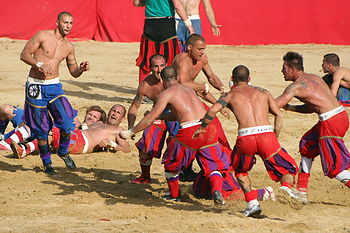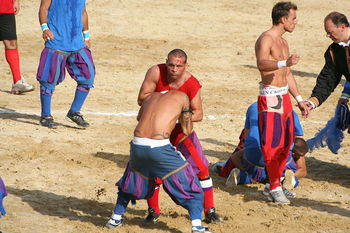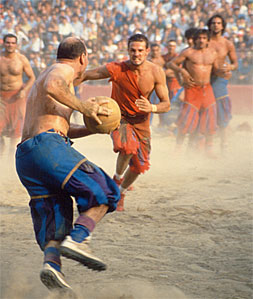Calcio Storico
Mix football with some rugby and you will get something what is in Italian city of Florence called Calcio Storico or Calcio Fiorentino.
Calcio Storico is a very old game. Nobody is absolutely sure about its origin. There are opinions that this sport comes from a very violent Roman game called „harpastum“. A small hard ball was used in the game. It was a game played by the legionnaires who in 59 BC established the colony of Florentia. Others say that Calcio Storico has its origin in a game called „sferomachia“ played in Ancient Greece. The game was later transferred to what is now Italy due to the fact that Ancient Greece was conquered by Rome in 146 BC.
In 1580 Florentine count Giovanni de' Bardi di Vernio published his "Treatise on football" - the first official rules of the calcio.
During the 1500's there were four teams which represented city districts - Bianchi (Whites) - Santo Spirito, Verdi (Greens) - San Giovanni, Rossi (Reds) - Santa Maria Novella and Azzurri (Blues) - Santa Croce.
The game „died“ in the 18th century. But in 1930 it was brought to life again. It became regular part of Florentine cultural calendar.
 Calcio Storico - spectacular medieval game
Calcio Storico - spectacular medieval game
During centuries rules of the game changed a bit.
Each team has 27 members which are lined up in three rows. Players wear historical costumes. The match lasts 50 minutes. The playing field is covered with sand.
 Rough kind of game with many injuries and brawls
Rough kind of game with many injuries and brawls
For the game to be played by the rules there are main referee, six linesmen and a field master. Despite their effort injuries and brawls during matches are very common.
The player runs with the ball in his hands and tries to pass it to other players in the team.
 Player trying to score a caccia (goal)
Player trying to score a caccia (goal)
There are wooden walls on each side of the field. The player has to toss over the wooden ball over the opposite wall. This means scoring a „caccia“ or a goal.
In the center of each goal wall a narrow white tent with red trimmings and a red flag guards its goal while the captain of the team with the flag bearer stand with the team’s flag near the tent.
Colours of the ball and tent depend on the colours of teams participating in the match. The winner is the team with more points or “cacce”.
The winning team gets Bistecca fiorentina (steaks) of a weight equal to that of a white calf. There is also fireworks honouring the winners.
There are three games organized each year. The games are played in late June and early July to coincide with the St. John's Day. Saint John is the Patron Saint of Florence.
Before each match there is a long procession. It starts at 4 pm. The complete route of the procession is Piazza Santa Maria Novella - Via de’Banchi - Via Rondinelli - Via Tornabuoni - Via Strozzi - Piazza della Republica - Via degli Speziali - Via Calzaiuoli - Piazza della Signora - Via della Ninna - Via de’Neri - Borgo Santa Croce.